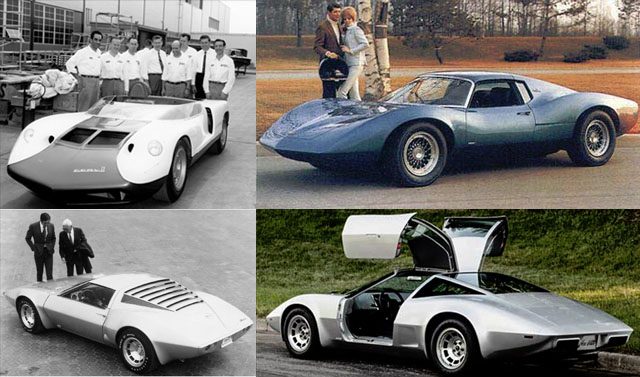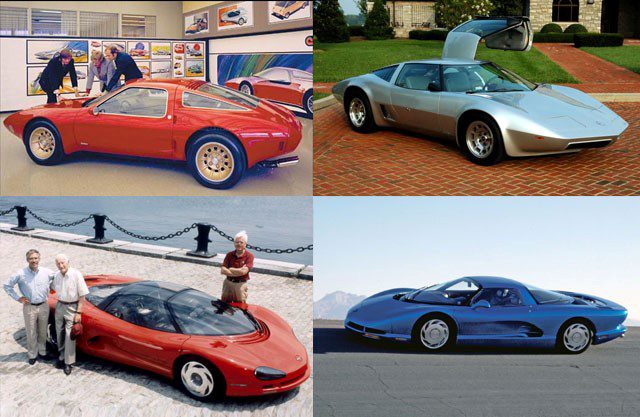C8 Corvette Mid Engine
With all the rumors, pictures and videos of the Mid-Engined C8, I though it would be fun to test your knowledge of past Mid-Engine Corvettes. Chevrolet has never produced a production mid-engine Corvette, but they have done many a prototype. How many can you name?
Starting in 1963, Chevrolet has made 8 known mid-engine prototypes! That is unless you count the 1959 XP-719 that may or may not have been a Corvette.

#1 – This first one was named the CERV II (Chevrolet Engineering Research Vehicle). Yes, there was a CERV I, but it was a test vehicle and not considered a Corvette. The CERV II was conceived early 1962, developed and built under Duntov’s direction between 1963 and 1964 as a separate line of racing Corvettes, but was rejected by GM management.
#2 – Next came the XP-880 “the Astro II” in 1968. This was Duntov’s first real effort at a production-ready mid-engine Corvette. It was built using off-the-shelf parts, a mid-mounted 427/390hp V8, and a two-speed transaxle from a Pontiac Tempest.
Duntov pushed hard for it to be the C4 Corvette, but it never happened.
#3 – XP-882 Aerovette Mid-engine Corvette concept was debuted at the 1970 New York Auto Show and impressed the car show crowd.
It turned out that its popularity was the reason Chevrolet never built it. Chevy was facing new competition in the mid-engine arena and wanted to be perceived as an engineering leader, so they scrapped the V8 for a new rotary-powered design and canceled the XP-882.
#4 – XP-895 “the Reynolds Corvette” was intended in 1973 to be a more production-ready version of the canceled XP-882.
The XP-895 used the same chassis as the 882 but that is where the comparison ends. The fiberglass body was replaced by an aluminum body created by aluminum distributor Reynolds. The powerplant was also replace with two Chevrolet 2-rotor engines joined together to make a 4-rotor, 420hp setup
Again, the popularity of the traditional fiberglass-bodied, front-engine Corvette ended up being the demise of the XP-895. The C3 was just selling too well to justify a totally new design, and GM went for easy money, keeping the C3 fresh with minor changes instead.

Here is a list of the other four prototypes (#5-#8):
#5 – XP-897GT also appeared in 1973 and was basically the same car as XP-895.
With the energy crisis in the 70’s, GM scrapped its rotary development work and all plans for a Wankel-powered car.
#6 – In 1976 Chevrolet was ready to produce the Aerovette one more time and was approved for production as a 1980 model.
With the rotary powerplant scrapped, a 350ci V8-powered engine was placed back in the Vette and the styling was updated, including gullwing doors. The production car had a target price between $15000-$18000.
What went wrong this time? Chief supporters Duntov, Bill Mitchell, and Ed Cole had all retired, imported rear mid-engine cars had poor sales, the Nissan 280Z was devouring Corvette sales and David R. McLellan (the new Chief Engineer) felt it would be better to keep the front engine design.
#7 – After around 10 years of no more mid-engine rumors, in 1986 GM introduced the “Corvette Indy”.
This was a very futuristic car with a 2.65-litre V8 from GM’s Indy car program, and very cutting-edge technology. The chassis was a composite monocoque, carbon-kevlar body, four-wheel-drive, and four-wheel-steering. The suspension was developed by Lotus, and instead of shocks and springs, used a complex, fully-hydraulic arrangement where microprocessors determined the exact position of each wheel based on acceleration values.
The new design proved to be very expensive, and customers were worried about a computer-controlled Vette, so once again, the mid-engine Corvette was canceled.
#8 – The CERV III was shown at the International Auto Show in Detroit in 1990.
Powered by a twin-turbo, quad-cam, 32-valve 5.7-litre V8 producing 650hp and 655 lb.-ft. of torque, giving the CERV III a theoretic top speed was 225 miles per hour and 0-62 mph of 3.9 seconds. The same engine, but without the turbos, would make its way into the 1990-1995 ZR1.
Again, it was just too expensive to build and sell. It was estimated the car would cost between $300,000 to $400,000 in 1990 dollars.


